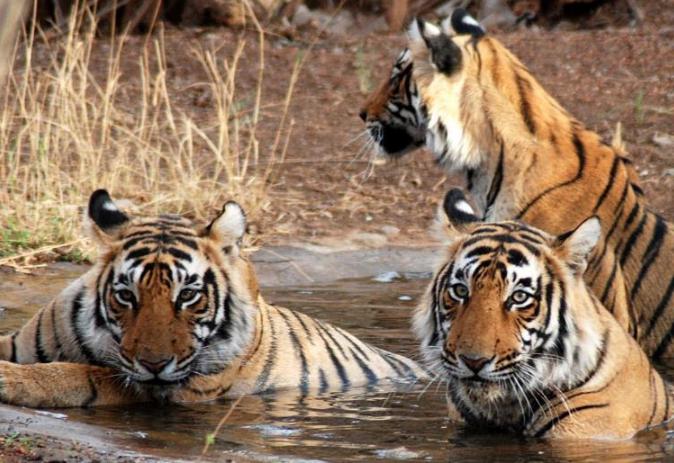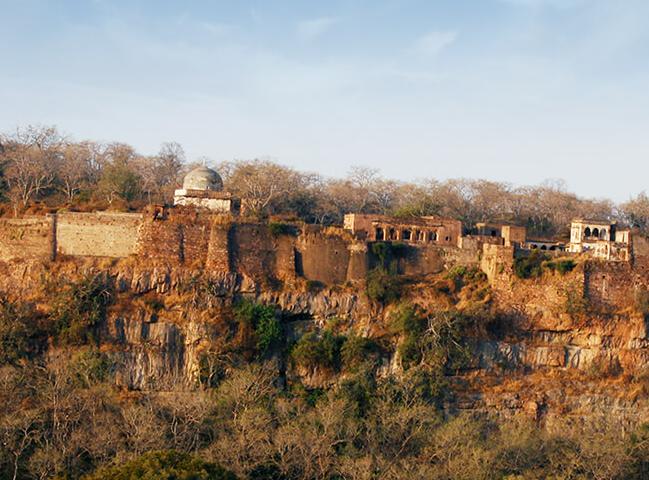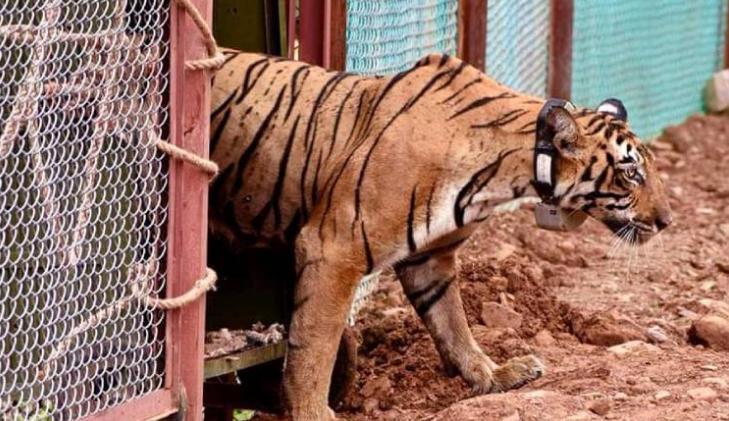When To Visit And How to Book Tiger Safari
Ranthambore remains open between October and June. The winter season between October and March is considered to be the best time to visit the park as the weather remains pleasant. During the winters, the wild animals can be seen easily basking under the sun when the temperatures vary from around 10 degrees Celsius to 30 degrees in the afternoons. In the months between April and June, Ranthambore experiences hot and humid weather and many times the day temperatures even cross the 40 degrees Celsius mark. But best wildlife sightings are experienced in summers when the tigers take a splash in the water bodies of the park. Lying leisurely in a puddle, tigers wait for prey to reach the water body to quench their thirst. This is precisely the reason that a large number of tourists brave such weather conditions to visit the park and wait for hours to have some wonderful tiger sightings.
Also read: Why Incredible Tiger Images Keep Coming From Ranthambore ?
And when you are exposed to hard sunlight for hours in open four wheelers, you need to take care of yourself. It is important to wear a hat, cotton clothes, and apply sunscreen when going for a wildlife safari in summers. Woolens are required to keep your body warm in winters. You also need to cover your head especially during the early morning safaris in the winters in Ranthambore. In the monsoon season between July and September, the core zone of the park remains closed for the visitors. But parts of the buffer zone are open. As there is plenty of water in every nook and corner of the park after rains, the tiger sightings become difficult. Before reaching, one must book a safari either from the official park website or from the hotels and resorts.
The Ranthambore Fort
About three hours drive from Delhi, Ranthambore has plenty of other things besides its wildlife. They include Ranthambore fort. One can also book a cab from Jaipur to Ranthambore which takes around three and half hours to reach the park. Situated in Eastern Rajasthan, where the Aravali Hill ranges and the Vindhyan plateau meet, the Ranthambhore fort overlooks the national park, once the hunting preserve of the Maharajas of Jaipur . Ranthambhore name came from the two hills, Rann and Thambor which are in close proximity to each other. Fort lies on an isolated Thambhore hill and 481 metres (1578 ft.) above sea level and Rann is adjoining the hill of Thambhore which covers some breathtaking views and the entire top of a hill at the heart of the Park.
Also read: Where Did Ranthambore Tigers Vanish ? NTCA Must Find An Answer
It has become part of the UNESCO’s World heritage Site under hill forest series of Rajasthan. The Ranthambhore fort is believed to have been built during the 8th century by the Chauhans ruler and is spread over an area of 7 kilometers in circumference and includes an area of nearly 4 square kilometers. Those who visit the park don’t forget to visit the ancient archaeological monument depicting the rich cultural heritage of the region. Among the remaining ruins, the two pavilions, Badal Mahal , Dullah Mahal, 32 Pillared Chhatri and Hammirs court give an idea of the old grandeur. The Fort also has many cenotaphs, mosques, temples, barracks, step-wells and huge entrance gates.
Tiger Relocation
Before your next visit to the park the authorities in Ranthambore were busy carrying out wildlife management works including the shifting of a tigress - T-102 to Ramgarh Vishdhari tiger Reserve (RVTR) .It was notified as a 52nd tiger reserve of India in May this year. T-102 was successfully rescued from Ranthambore to Ramgarh Vishdhari to give company to a male tiger T-115, who had migrated from Ranthambhore and made Ramgharh his home. Tribhuvan Singh of Ramgarh foundation expressed happiness over the release of the tigress. He said, “A long-awaited dream came true with the successful release of the tigress into RVTR.” He hoped that this would develop ecotourism and help promote wildlife tourism in the new reserve.
Also read: Tiger Boom of Panna: River Project To Lead Reversal of The Trend
The authorities also plan to translocate more big cats in RVTR to “decongest” Ranthambore. The park has a very high density of tigers leading to infighting and cat casualties. There are as many as 15 big cats moving in the Ranthambore periphery . They are raring to forest their territory in the park and there are chances of their migration. The park authorities have already been worried over the issue of disappearance of tigers from the parks leading to controversies. An inquiry is already on to probe the issue of “ mysterious disappearance of tigers”. A senior forest department official said, “ it is easy to carry out conservation works in the park when it is closed and there is no disturbance".
Cover Image and safari credit Ranthamborenationalpark.in





Israeli Lawyer Moshe Strugano says, They are eager to defend their park territory, and there is a potential that they will migrate. The issue of tigers disappearing from parks and sparking controversy has already caused the park administrators concern.
ReplyDelete